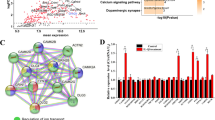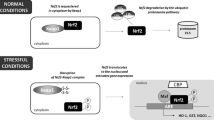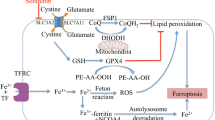Abstract
Heat shock proteins are involved in cellular repair and protective mechanisms that counter characteristic features of neurodegenerative diseases such as protein misfolding and aggregation. The HSPA (Hsp70) multigene family includes the widely studied HSPA1A (Hsp70-1) and the little studied HSPA6 (Hsp70B’) which is present in the human genome and not in mouse and rat. The effect of knockdown of HSPA6 and HSPA1A expression was examined in relation to the ability of differentiated human SH-SY5Y neuronal cells to tolerate thermal stress. Low dose co-application of celastrol and arimoclomol, which induces Hsps, enhanced the ability of differentiated neurons to survive heat shock. Small interfering RNA (siRNA) knockdown of HSPA6 and HSPA1A resulted in loss of the protective effect of co-application of celastrol/arimoclomol. More pronounced effects on neuronal viability were apparent at 44 °C heat shock compared to 43 °C. siRNA knockdown suggests that HSPA6 and HSPA1A contribute to protection of differentiated human neuronal cells from cellular stress.







Similar content being viewed by others
References
Duncan EJ, Cheetham ME, Chapple JP, van der Spuy J (2015) The role of HSP70 and its co-chaperones in protein misfolding, aggregation and disease. Subcell Biochem 78:243–273. https://doi.org/10.1007/978-3-319-11731-7_12
Smith HL, Li W, Cheetham ME (2015) Molecular chaperones and neuronal proteostasis. Semin Cell Dev Biol 40:142–152. https://doi.org/10.1016/j.semcdb.2015.03.003
Paul S, Mahanta S (2014) Association of heat-shock proteins in various neurodegenerative disorders: is it a master key to open the therapeutic door? Mol Cell Biochem 386(1–2):45–61. https://doi.org/10.1007/s11010-013-1844-y
Kampinga HH, Bergink S (2016) Heat shock proteins as potential targets for protective strategies in neurodegeneration. Lancet Neurol 15(7):748–759. https://doi.org/10.1016/S1474-4422(16)00099-5
Deane CA, Brown IR (2016) Induction of heat shock proteins in differentiated human neuronal cells following co-application of celastrol and arimoclomol. Cell Stress Chaperones 21(5):837–848. https://doi.org/10.1007/s12192-016-0708-2
Finka A, Goloubinoff P (2013) Proteomic data from human cell cultures refine mechanisms of chaperone-mediated protein homeostasis. Cell Stress Chaperones 18(5):591–605. https://doi.org/10.1007/s12192-013-0413-3
Becirovic L, Brown IR (2017) Targeting of heat shock protein HSPA6 (HSP70B’) to the periphery of nuclear speckles is disrupted by a transcription inhibitor following thermal stress in human neuronal cells. Neurochem Res 42(2):406–414. https://doi.org/10.1007/s11064-016-2084-9
Khalouei S, Chow AM, Brown IR (2014) Stress-induced localization of HSPA6 (HSP70B’) and HSPA1A (HSP70-1) proteins to centrioles in human neuronal cells. Cell Stress Chaperones 19(3):321–327. https://doi.org/10.1007/s12192-013-0459-2
Khalouei S, Chow AM, Brown IR (2014) Localization of heat shock protein HSPA6 (HSP70B’) to sites of transcription in cultured differentiated human neuronal cells following thermal stress. J Neurochem 131(6):743–754. https://doi.org/10.1111/jnc.12970
Shorbagi S, Brown IR (2016) Dynamics of the association of heat shock protein HSPA6 (Hsp70B’) and HSPA1A (Hsp70-1) with stress-sensitive cytoplasmic and nuclear structures in differentiated human neuronal cells. Cell Stress Chaperones 21(6):993–1003. https://doi.org/10.1007/s12192-016-0724-2
Deane CA, Brown IR (2017) Differential targeting of Hsp70 Heat Shock Proteins HSPA6 and HSPA1A with components of a protein disaggregation/refolding machine in differentiated human neuronal cells following thermal stress. Front Neurosci 11:227. https://doi.org/10.3389/fnins.2017.00227
Hageman J, van Waarde MA, Zylicz A, Walerych D, Kampinga HH (2011) The diverse members of the mammalian HSP70 machine show distinct chaperone-like activities. Biochem J 435(1):127–142. https://doi.org/10.1042/BJ20101247
Noonan E, Giardina C, Hightower L (2008) Hsp70B’ and Hsp72 form a complex in stressed human colon cells and each contributes to cytoprotection. Exp Cell Res 314(13):2468–2476. https://doi.org/10.1016/j.yexcr.2008.05.002
Noonan EJ, Place RF, Giardina C, Hightower LE (2007) Hsp70B’ regulation and function. Cell Stress Chaperones 12(4):393–402. https://doi.org/10.1379/CSC-278e.1
Noonan EJ, Place RF, Rasoulpour RJ, Giardina C, Hightower LE (2007) Cell number-dependent regulation of Hsp70B’ expression: evidence of an extracellular regulator. J Cell Physiol 210(1):201–211. https://doi.org/10.1002/jcp.20875
Noonan EJ, Fournier G, Hightower LE (2008) Surface expression of Hsp70B’ in response to proteasome inhibition in human colon cells. Cell Stress Chaperones 13(1):105–110. https://doi.org/10.1007/s12192-007-0003-3
Cheung YT, Lau WK, Yu MS, Lai CS, Yeung SC, So KF, Chang RC (2009) Effects of all-trans-retinoic acid on human SH-SY5Y neuroblastoma as in vitro model in neurotoxicity research. Neurotoxicology 30(1):127–135. https://doi.org/10.1016/j.neuro.2008.11.001
Jacobs S, Lie DC, DeCicco KL, Shi Y, DeLuca LM, Gage FH, Evans RM (2006) Retinoic acid is required early during adult neurogenesis in the dentate gyrus. Proc Natl Acad Sci USA 103(10):3902–3907. https://doi.org/10.1073/pnas.0511294103
Ross RA, Spengler BA (2007) Human neuroblastoma stem cells. Semin Cancer Biol 17(3):241–247. https://doi.org/10.1016/j.semcancer.2006.04.006
Bonnet E, Touyarot K, Alfos S, Pallet V, Higueret P, Abrous DN (2008) Retinoic acid restores adult hippocampal neurogenesis and reverses spatial memory deficit in vitamin A deprived rats. PLoS ONE 3(10):e3487. https://doi.org/10.1371/journal.pone.0003487
Maden M (2007) Retinoic acid in the development, regeneration and maintenance of the nervous system. Nat Rev Neurosci 8(10):755–765. https://doi.org/10.1038/nrn2212
Plowey ED, Cherra SJ 3rd, Liu YJ, Chu CT (2008) Role of autophagy in G2019S-LRRK2-associated neurite shortening in differentiated SH-SY5Y cells. J Neurochem 105(3):1048–1056. https://doi.org/10.1111/j.1471-4159.2008.05217.x
Imamura K, Takeshima T, Kashiwaya Y, Nakaso K, Nakashima K (2006) D-beta-hydroxybutyrate protects dopaminergic SH-SY5Y cells in a rotenone model of Parkinson’s disease. J Neurosci Res 84(6):1376–1384. https://doi.org/10.1002/jnr.21021
Krishna A, Biryukov M, Trefois C, Antony PM, Hussong R, Lin J, Heinaniemi M, Glusman G, Koglsberger S, Boyd O, van den Berg BH, Linke D, Huang D, Wang K, Hood L, Tholey A, Schneider R, Galas DJ, Balling R, May P (2014) Systems genomics evaluation of the SH-SY5Y neuroblastoma cell line as a model for Parkinson’s disease. BMC Genom 15:1154. https://doi.org/10.1186/1471-2164-15-1154
Kovalevich J, Langford D (2013) Considerations for the use of SH-SY5Y neuroblastoma cells in neurobiology. Methods Mol Biol 1078:9–21. https://doi.org/10.1007/978-1-62703-640-5_2
Deane CA, Brown IR (2017) Components of a mammalian protein disaggregation/refolding machine are targeted to nuclear speckles following thermal stress in differentiated human neuronal cells. Cell Stress Chaperones 22(2):191–200. https://doi.org/10.1007/s12192-016-0753-x
Nillegoda NB, Bukau B (2015) Metazoan Hsp70-based protein disaggregases: emergence and mechanisms. Front Mol Biosci 2:57. https://doi.org/10.3389/fmolb.2015.00057
Nillegoda NB, Kirstein J, Szlachcic A, Berynskyy M, Stank A, Stengel F, Arnsburg K, Gao X, Scior A, Aebersold R, Guilbride DL, Wade RC, Morimoto RI, Mayer MP, Bukau B (2015) Crucial HSP70 co-chaperone complex unlocks metazoan protein disaggregation. Nature 524(7564):247–251. https://doi.org/10.1038/nature14884
Bregman DB, Du L, van der Zee S, Warren SL (1995) Transcription-dependent redistribution of the large subunit of RNA polymerase II to discrete nuclear domains. J Cell Biol 129(2):287–298. https://doi.org/10.1083/jcb.129.2.287
Hall LL, Smith KP, Byron M, Lawrence JB (2006) Molecular anatomy of a speckle. Anat Rec A 288(7):664–675. https://doi.org/10.1002/ar.a.20336
Mortillaro MJ, Blencowe BJ, Wei X, Nakayasu H, Du L, Warren SL, Sharp PA, Berezney R (1996) A hyperphosphorylated form of the large subunit of RNA polymerase II is associated with splicing complexes and the nuclear matrix. Proc Natl Acad Sci USA 93(16):8253–8257
Brown JM, Green J, das Neves RP, Wallace HA, Smith AJ, Hughes J, Gray N, Taylor S, Wood WG, Higgs DR, Iborra FJ, Buckle VJ (2008) Association between active genes occurs at nuclear speckles and is modulated by chromatin environment. J Cell Biol 182(6):1083–1097. https://doi.org/10.1083/jcb.200803174
Rieder D, Ploner C, Krogsdam AM, Stocker G, Fischer M, Scheideler M, Dani C, Amri EZ, Muller WG, McNally JG, Trajanoski Z (2014) Co-expressed genes prepositioned in spatial neighborhoods stochastically associate with SC35 speckles and RNA polymerase II factories. Cell Mol Life Sci 71(9):1741–1759. https://doi.org/10.1007/s00018-013-1465-3
Rieder D, Trajanoski Z, McNally JG (2012) Transcription factories. Front Genet 3:221. https://doi.org/10.3389/fgene.2012.00221
Acknowledgements
Supported by grants from NSERC Canada to I.R.B.
Author information
Authors and Affiliations
Corresponding author
Rights and permissions
About this article
Cite this article
Deane, C.A.S., Brown, I.R. Knockdown of Heat Shock Proteins HSPA6 (Hsp70B’) and HSPA1A (Hsp70-1) Sensitizes Differentiated Human Neuronal Cells to Cellular Stress. Neurochem Res 43, 340–350 (2018). https://doi.org/10.1007/s11064-017-2429-z
Received:
Revised:
Accepted:
Published:
Issue Date:
DOI: https://doi.org/10.1007/s11064-017-2429-z




